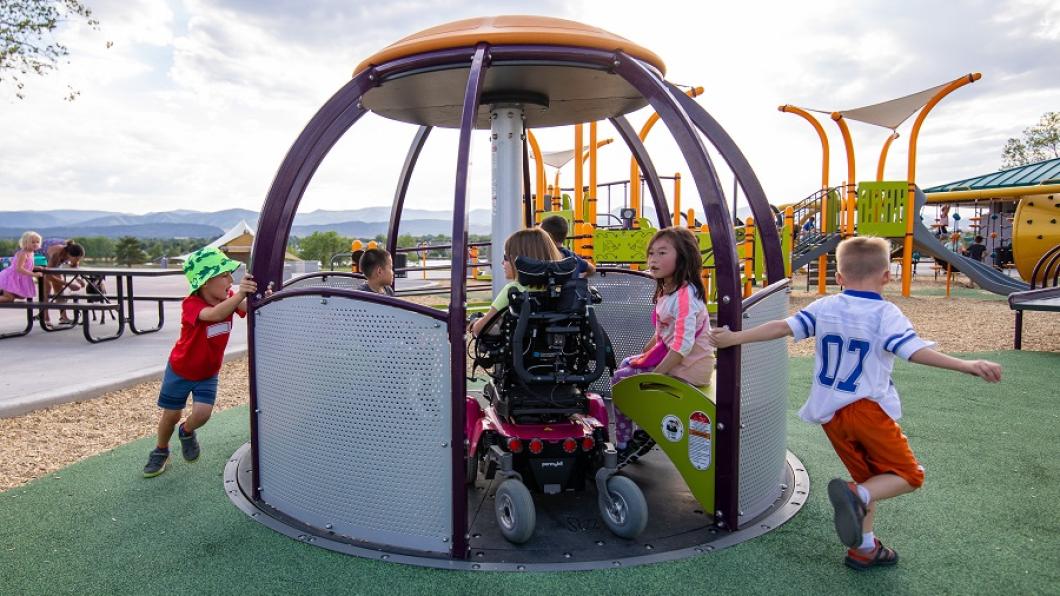
EPIC Lab launches new playgrounds playbook to help communities create more accessible play spaces for kids of all abilities
When you think of playgrounds, they should be spaces where children can come, play, and have fun with their family and friends. While there has been a shift toward creating accessible playgrounds in recent years, many families living with disability are often still excluded from these important spaces. This is because the design of many playgrounds and their surroundings are still not fully accessible.
Tim Ross and his research team at the Bloorview Research Institute’s EPIC Lab are hoping to change this. EPIC stands for Engagement & Planning for Inclusive Communities – and that is just what Dr. Ross and his team plan to do: advance more inclusive communities by creating inclusive play environments for children of all abilities.
“Playgrounds are special places where children can challenge themselves, make their own decisions, connect with others, and engage their imagination. These spaces contribute to children’s health and well-being, and can help strengthen family relations,” says Ross, a scientist at the BRI and assistant professor (status) at the University of Toronto’s Department of Geography & Planning and Rehabilitation Sciences Institute. “We need to make access to these spaces equitable so that all kids – and their families! – can easily access playgrounds across Canada and beyond.”
Holland Bloorview’s EPIC Lab has teamed up with Dr. Kelly Arbour-Nicitopoulos (University of Toronto), Ms. Ingrid Kanics (Kanics Inclusive Design Services, LLC), and Dr. Jennifer Leo (University of Alberta) to create a comprehensive report titled, “Creating Inclusive Playgrounds: A Playbook of Considerations and Strategies.”
The development of this playbook has received generous support from Canadian Tire Jumpstart Charities’ Inclusive Play Project and their mission to build more inclusive play spaces across Canada.
The 141-page playbook offers municipalities, schools, community groups, practitioners (e.g., designers, planners, builders, developers), and families living with disability a comprehensive resource for creating accessible and inclusive playgrounds. And unlike other playground resources, the playbook goes beyond the typical boundaries of playground design. It does so by taking into account topics such as community engagement, play programming, playground surroundings, service and maintenance, and more.
The playbook helps those who are interested in creating inclusive play spaces within their communities to focus on four key questions: 1) How do we start? 2) Can I get there? 3) Can I play? and 4) Can I stay? The resource then guides the reader through important considerations and strategies relating to a wide array of specific issues, including site selection, accessible parking and pathways, signage and wayfinding, playground safety, and facilities and amenities that are needed in the surrounding environment.
“Having an inclusive and accessible play space close to home would be a game-changer for Noah,” says Iwan Mota, a parent who is collaborating with Dr. Ross on another research study related to developing and carrying out play-based therapies on accessible playgrounds.
Mota’s six-year-old son lives with a spinal cord injury as a result of cancer and has been receiving ongoing occupational and physical therapy from Holland Bloorview for the past few years. Noah has been using a wheelchair since he was a year and a half and hasn’t been able to access most of the playgrounds in Toronto’s neighbourhoods because they are not designed for children with disabilities.
“It limits his abilities to join his friends during playtime. Adding accessibility to a playground would enable kids of all abilities to play, creating a more inclusive environment,” says Mota. “It is a shame we don’t have more across the province. There are very few options.”
Mota also points out that the playgrounds have been designed using elements that are not barrier-free, for example, using woodchips and play structures that inhibit the access and play of children with mobility devices.
Having accessible washrooms is also critically important in enabling children and their families to stay longer at a playground without having to rush home to tend to personal needs. "Noah is getting to that age where he is noticing more how he is different from his friends; removing barriers to play and creating more inclusive play environments is an important step in making him feel like he was part of the thought process when designing these structures, and to not think less of himself as a member of society."
Download the free Inclusive Playgrounds Playbook: https://hollandbloorview.ca/playgroundsplaybook.
Related Stories:
Holland Bloorview celebrates the launch of its accessible playground
What one mom did to get her disabled son on the playground